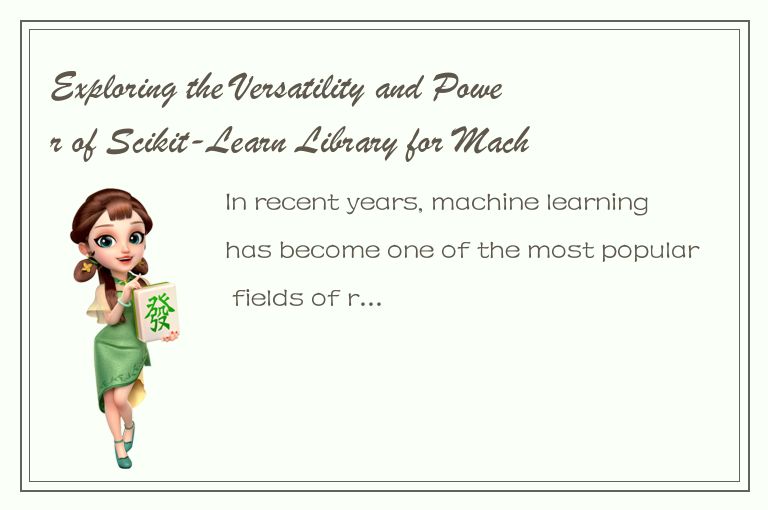In recent years, machine learning has become one of the most popular fields of research and development. Machine learning algorithms are used in a wide range of applications, from predictive modeling in finance to image recognition in computer vision. The success of machine learning applications lies in the ability to learn from data and make predictions or decisions based on patterns in the data. However, to apply machine learning, one needs a powerful and flexible library to implement it. One such library is scikit-learn, a Python library for machine learning that is widely used in research and industry.

Scikit-learn is an open-source library built on NumPy, SciPy, and matplotlib. It provides a range of algorithms for supervised and unsupervised learning, including regression, classification, clustering, and dimensionality reduction. Some of the algorithms include linear and logistic regression, decision trees, random forests, k-means clustering, and principal component analysis (PCA). In addition, scikit-learn provides pre-processing tools such as data normalization, feature scaling, and missing data imputation. The library also includes utilities for model selection, including cross-validation and hyperparameter tuning.
Scikit-learn scores over other libraries in various aspects, as the following:
Easy-to-use: Scikit-learn has a user-friendly and intuitive API (Application Programming Interface), which makes it easy for developers to use.
Flexible: Scikit-learn is flexible enough to be used in various machine learning scenarios, from simple to complex problems.
Compatibility: Scikit-learn is compatible with other Python packages, including NumPy, SciPy, pandas, and matplotlib.
Community support: Scikit-learn has a large and active community of developers, which provides extensive support, tutorials, and code examples.
Performance: Scikit-learn is optimized for high performance, making it suitable for large-scale machine learning tasks.
Now let us explore some of the most popular applications of scikit-learn.
Classification
Classification is a form of supervised learning where the goal is to categorize input data into one of several categories. Scikit-learn provides a range of classification algorithms, including logistic regression, decision trees, random forests, and support vector machines (SVM). One of the most important features of scikit-learn's classification algorithms is the ability to handle multi-class problems, meaning they are capable of classifying data into more than two classes. Scikit-learn also supports different scoring metrics for classification problems, including accuracy, precision, recall, and F1 score.
Regression
Regression is another form of supervised learning where the goal is to predict a continuous output variable based on input data. Scikit-learn provides a range of regression algorithms, including linear regression, Lasso and Ridge regression, decision trees, random forests, and SVMs. Scikit-learn also includes metrics for measuring the performance of regression algorithms, including mean squared error (MSE), root mean squared error (RMSE), and R-squared.
Clustering
Clustering is an unsupervised learning technique that groups data points together based on their similarity. Scikit-learn provides a range of clustering algorithms, including k-means clustering, hierarchical clustering, and DBSCAN. Clustering can be used for a wide range of applications, including customer segmentation, anomaly detection, and image segmentation.
Dimensionality Reduction
Dimensionality reduction is a process of reducing the number of input features while still maintaining the relevant information. Scikit-learn provides a range of dimensionality reduction techniques, including PCA, t-SNE, and LLE. Dimensionality reduction can be used to visualize high-dimensional data, reduce the computational complexity of machine learning algorithms, and improve the performance of machine learning models.
Conclusion
Scikit-learn is a versatile and powerful library for machine learning applications. It provides a range of algorithms for supervised and unsupervised learning, as well as pre-processing tools, model selection utilities, and performance metrics. Scikit-learn is easy to use, flexible, compatible with other Python packages, and has extensive community support. It can be used for a wide range of machine learning applications, including classification, regression, clustering, and dimensionality reduction. So, it's recommended that anyone who wants to implement machine learning must explore the versatility and power of scikit-learn library for their application.




 QQ客服专员
QQ客服专员 电话客服专员
电话客服专员